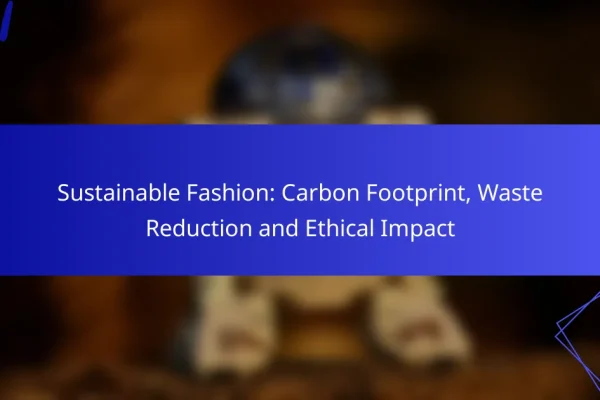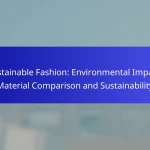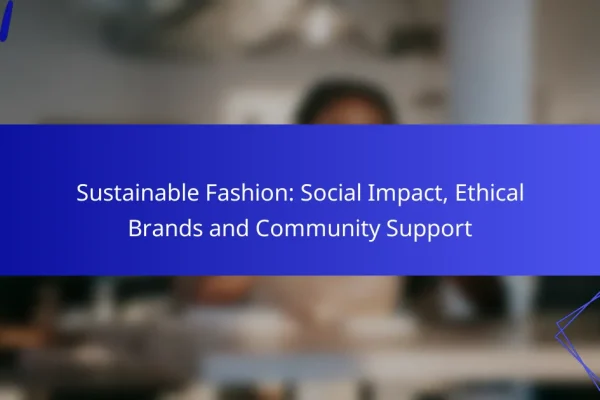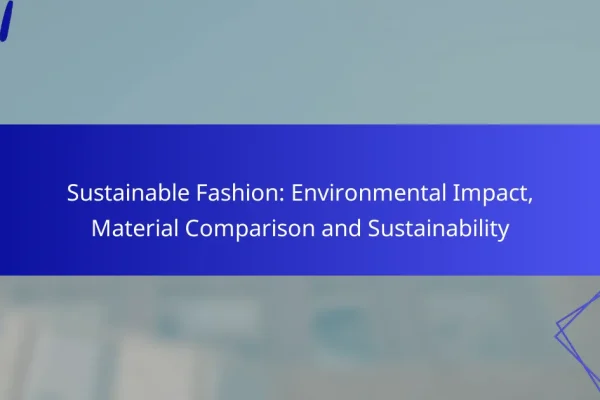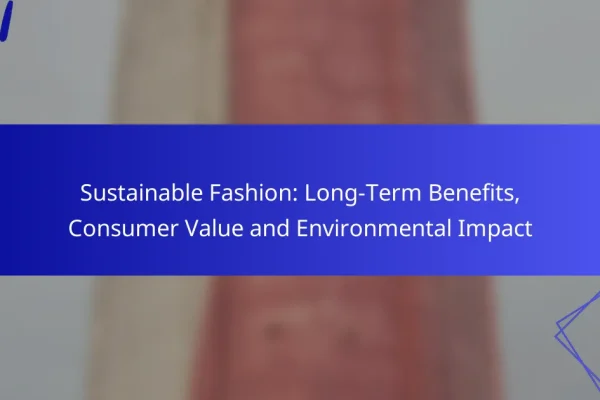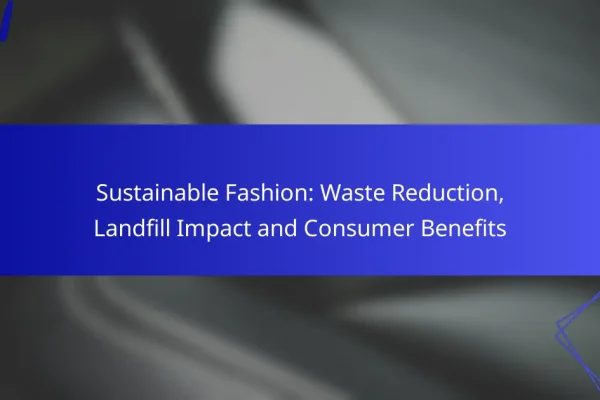How does sustainable fashion impact the environment?
Sustainable fashion significantly reduces negative environmental effects by promoting eco-friendly practices throughout the clothing lifecycle. This approach focuses on minimizing resource consumption, reducing pollution, and fostering a circular economy.
Reduction of carbon footprint
The reduction of carbon footprint in sustainable fashion is achieved through various methods, such as using organic materials and implementing energy-efficient production processes. Brands often prioritize local manufacturing to cut down on transportation emissions, which can account for a substantial portion of a garment’s total carbon output.
For instance, choosing clothing made from organic cotton or recycled materials can lower carbon emissions by up to 50% compared to conventional textiles. Consumers can further contribute by selecting brands that disclose their carbon footprint and commit to reducing it over time.
Minimization of waste
Sustainable fashion aims to minimize waste through practices like upcycling, recycling, and producing garments with a longer lifespan. By designing clothes that are durable and timeless, brands can reduce the frequency of purchases and the amount of discarded clothing.
Additionally, many companies are adopting take-back programs, allowing consumers to return old garments for recycling or repurposing. This not only diverts textiles from landfills but also encourages a more responsible consumption mindset.
Conservation of water resources
The conservation of water resources is a critical aspect of sustainable fashion, as traditional textile production is notoriously water-intensive. Sustainable brands often utilize techniques such as rain-fed cotton farming and closed-loop water systems to significantly reduce water usage.
For example, producing one pair of jeans can require over 7,000 liters of water in conventional methods, while sustainable practices can cut this figure down to a fraction. Consumers can help by choosing brands that prioritize water-efficient practices and support initiatives aimed at reducing water consumption in the fashion industry.
What are the benefits of sustainable fashion for consumers?
Sustainable fashion offers numerous benefits for consumers, including healthier materials, unique fashion choices, and support for ethical brands. By choosing sustainable options, consumers can enjoy clothing that is better for their health and the environment while expressing their individuality.
Healthier materials
Sustainable fashion often utilizes organic or recycled materials that are free from harmful chemicals. This reduces the risk of skin irritations and allergies, making clothing safer for everyday wear. For example, organic cotton is grown without pesticides, resulting in a softer and safer fabric.
Additionally, sustainable brands may adhere to strict standards, such as GOTS (Global Organic Textile Standard), ensuring that materials are not only eco-friendly but also produced under fair labor conditions. Consumers can feel confident that their clothing choices are contributing to a healthier planet.
Unique fashion choices
Sustainable fashion promotes individuality through unique designs and limited production runs. Many sustainable brands focus on craftsmanship and creativity, offering styles that stand out from mass-produced clothing. This allows consumers to express their personal style while supporting innovative designers.
Moreover, vintage and second-hand clothing are integral to sustainable fashion, providing consumers with one-of-a-kind pieces. Thrift shopping or exploring online resale platforms can lead to discovering rare items that reflect personal taste and reduce waste.
Support for ethical brands
By choosing sustainable fashion, consumers actively support brands that prioritize ethical practices. These brands often ensure fair wages, safe working conditions, and environmentally friendly production methods. This conscious consumerism fosters a more equitable fashion industry.
Furthermore, many sustainable brands engage in community initiatives or donate a portion of their profits to social causes. Consumers can feel empowered knowing their purchases contribute to positive change, aligning their values with their fashion choices.
How can consumers adopt sustainable fashion practices?
Consumers can adopt sustainable fashion practices by making conscious choices that reduce environmental impact. This includes selecting eco-friendly materials, supporting ethical brands, and embracing a circular economy through practices like buying second-hand and participating in clothing swaps.
Choosing second-hand clothing
Buying second-hand clothing is a practical way to promote sustainable fashion. It extends the life of garments and reduces waste, as many items end up in landfills. Thrift stores, online marketplaces, and local consignment shops offer a wide variety of styles at lower prices compared to new items.
When shopping for second-hand clothing, look for quality pieces that are still in good condition. Check for signs of wear, such as fraying seams or stains, and consider the fabric type, as natural fibers tend to last longer. This practice not only saves money but also supports a more sustainable fashion ecosystem.
Investing in quality over quantity
Investing in quality clothing rather than buying many cheaper items is a key aspect of sustainable fashion. High-quality garments often last longer and perform better, reducing the need for frequent replacements. Aim for versatile pieces that can be mixed and matched to create various outfits.
Consider brands that prioritize sustainable materials and ethical production practices. While the initial cost may be higher, the long-term savings and reduced environmental impact make it a worthwhile investment. Look for certifications like Fair Trade or GOTS to ensure ethical standards are met.
Participating in clothing swaps
Clothing swaps are a fun and sustainable way to refresh your wardrobe without purchasing new items. By exchanging clothes with friends or community members, you can find new styles while giving your old clothes a second life. Organizing a swap can be as simple as inviting friends over and setting up a space for exchanging garments.
To make the most of a clothing swap, set some ground rules, such as the number of items each participant can bring. This helps ensure a fair exchange and keeps the event organized. Additionally, consider donating any leftover items to local charities to further support sustainable practices.
What role do brands play in promoting sustainable fashion?
Brands play a crucial role in promoting sustainable fashion by adopting practices that minimize environmental impact and enhance social responsibility. Their choices in production, supply chain management, and labor practices significantly influence consumer behavior and industry standards.
Implementing eco-friendly production processes
Eco-friendly production processes involve using sustainable materials, reducing waste, and minimizing energy consumption. Brands can adopt practices such as utilizing organic cotton, recycled fabrics, and water-efficient dyeing techniques. For example, many companies are shifting towards biodegradable materials to lessen their ecological footprint.
Additionally, brands should consider lifecycle assessments to evaluate the environmental impact of their products from raw material extraction to disposal. This approach helps identify areas for improvement and encourages sustainable innovation.
Transparency in supply chains
Transparency in supply chains is essential for fostering trust and accountability in sustainable fashion. Brands should disclose information about their sourcing, manufacturing processes, and labor conditions. This transparency allows consumers to make informed choices and supports ethical practices.
Many brands are now using blockchain technology to track their products from origin to store, ensuring that all steps meet sustainability standards. This not only enhances brand reputation but also encourages industry-wide changes towards greater accountability.
Engaging in fair labor practices
Engaging in fair labor practices means ensuring that workers are treated ethically and compensated fairly. Brands should adhere to international labor standards, providing safe working conditions and fair wages. This commitment not only benefits workers but also enhances brand loyalty among consumers who prioritize ethical consumption.
Brands can implement regular audits and collaborate with third-party organizations to verify compliance with labor standards. By actively promoting fair labor practices, brands contribute to a more equitable fashion industry and help combat exploitation in garment production.
How does sustainable fashion influence the economy?
Sustainable fashion significantly influences the economy by creating new job opportunities, stimulating local markets, and driving innovation in materials. This shift towards eco-friendly practices not only benefits the environment but also fosters economic growth and resilience.
Creation of green jobs
The rise of sustainable fashion leads to the creation of green jobs across various sectors, including manufacturing, retail, and recycling. These positions often focus on environmentally friendly practices, such as organic farming for textiles or eco-conscious production methods.
For instance, companies that prioritize sustainability may hire workers skilled in natural dyeing techniques or waste reduction strategies. This not only provides employment but also encourages a workforce that is knowledgeable about sustainable practices.
Boosting local economies
Sustainable fashion can significantly boost local economies by supporting small businesses and artisans. When consumers choose to buy locally produced, sustainable clothing, they contribute directly to their community’s economic health.
Local fashion initiatives often emphasize the use of regional materials, which reduces transportation costs and carbon footprints. This practice can lead to a more vibrant local economy, as money spent on local goods tends to circulate within the community.
Encouraging innovation in materials
The demand for sustainable fashion drives innovation in materials, leading to the development of new, eco-friendly textiles. Brands are increasingly exploring alternatives to traditional fabrics, such as organic cotton, hemp, and recycled materials.
For example, some companies are now using recycled plastics to create durable fabrics, reducing waste and promoting a circular economy. This innovation not only meets consumer demand for sustainable options but also encourages further research and development in sustainable materials.
What are the challenges faced by the sustainable fashion industry?
The sustainable fashion industry encounters several significant challenges that hinder its growth and adoption. Key issues include higher production costs, limited consumer awareness, and supply chain complexities.
Higher production costs
Sustainable fashion often involves higher production costs compared to conventional methods. This is primarily due to the use of eco-friendly materials, ethical labor practices, and sustainable manufacturing processes, which can be more expensive to implement.
For instance, organic cotton or recycled fabrics typically cost more than standard materials. Brands may also invest in certifications like Fair Trade or GOTS, which add to overall expenses. As a result, sustainable fashion items may retail at a premium, making them less accessible to price-sensitive consumers.
To navigate these costs, brands can consider strategies such as optimizing supply chains, investing in technology for efficiency, or focusing on a niche market willing to pay for sustainability. Educating consumers about the long-term value of sustainable products can also help justify higher prices.
